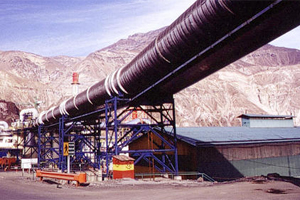Temperature
It is the amount of heat the atmosphere has, depending on the energy the sun generates. Due to this, it is directly related to solar radiation.
Although the sun shines its rays directly towards our planet, they don’t reach the Earth’s atmosphere whole.
One of the main causes is the atmosphere’s protective action (ozone layer), which prevents the entry of harmful rays and retains a fair amount of radiation in its upper part.
Temperature varies according to the place of the planet (latitude) we are located in, because not all of the planet’s areas receive the same amount of solar radiation.
The Earth’s position in relation to the sun and its movement around it condition the arrival of solar rays to the equator (where temperatures are very high), while in the polar zones radiation scarcely passes, thus diminishing temperature.
There are several instruments to measure a place’s temperature. Stand outs among them are maximum and minimum thermometers, which, as their name indicates, serve to measure extreme temperatures at a specific moment. Although they perform the same function, their structure is different because the first contains mercury within and the second one has alcohol.
Usually, atmospheric temperature is measured in Celsius degrees (°C), but there are also other scales of thermal measurement, like Fahrenheit or Kelvin.
Atmospheric pressure
It refers to the force the atmosphere exerts in all directions due to the weight of its upper layers and the attraction (force of gravity) the Earth’s surface exerts. The unit used to measure pressure is the atmosphere, defined as the amount of weight a 760 millimeter high column of mercury exerts at a latitude of 45° at sea level and at a temperature of 0° centigrade.
In meteorology, millibars or mercury millimeters are used. The relationship between these measurements is the following: 1 atmosphere is 1.013,2 millibars or 760 mercury millimeters.
Atmospheric pressure decreases with altitude due to the fact that the higher a point is over sea level, the fewer layers of air is has above it.
This decrease is not the same for the entire atmosphere, it is of 1.33 millibars for every 11 meters of ascension; while in the higher atmospheric layers the decrease is slower.
Likewise, if we move horizontally, atmospheric pressure is not the same everywhere because if we find ourselves where the air is cold, it descends and generates a higher pressure on Earth, while if the air heats up, it rises and there will be low pressure on the surface. Low pressure centers are dubbed cyclones, while high pressure ones receive the name of anticyclones.
The main instrument used for its analysis is the mercury barometer, instrument made up of a crystal tube full of mercury, with an pen end dipped in a bucket. There is also an aneroid barometer whose variations are expressed by the hands of a clock.
Winds
The air contained in our atmosphere is in constant movement due to currents or winds. They travel trough the atmosphere based on pressure differences and are capable of moving air from areas of higher pressure to lower ones.
When the atmosphere heats up, first it does so from its lower layer up to the upper one, which causes air dilation. Gradually, the air begins to rise, creating a constant circular flow.
Earth spins on its axis from west to east, causing a deviation of all objects in motion, including winds. This effect is called Coriolis effect. It states that all objects in motion located in the northern hemisphere, including water masses, deviate clockwise, while those located in the southern hemisphere take the opposite direction.
It is possible to identify to main groups of winds, which are classified according to the surface they cover in their route and their regularity.We speak of planetary winds when we refer to those that cover and move through great stretches of land, while we refer to local winds when discussing those that are ruled by topographic conditions of a specific area and are more limited.
Planetary (prevailing) winds are Easterlies, Westerlies and circumpolar winds. Easterlies circulate between the tropics, from 30 or 35°latitude towards the equator. They head from high subtropical pressures towards low equatorial pressures. Given the fact that these winds come from the east, they are also called east winds, and thanks to the Coriolis effect, always move to the west. Equatorial air rises, cools and moves from north to south, drifting from the equatorial region. Around 30° northern latitude, air cools more and more and begins its descent. The descending air begins to heat up and flows along the surface towards the north, to the pole, or to the south, towards the equator. We refer to Westerlies when discussing winds that move from the tropics to the poles and the wind currents that flow towards the south become northern low latitude Westerlies.
The upper layer air continues heading slowly towards the north and cooling, finally descending in the polar region. There, it cools even more at a superficial level and flows towards the south. These air masses are dubbed circumpolar winds (which circulate the poles).
The circulation of air masses in the southern hemisphere are produced in a similar fashion to those described here for the northern hemisphere.
In the case of local winds, there is an enormous variety, each with its own characteristics.
Among the most well known we can name the Chinook, dry wind that blows from north to east in the Rocky Mountains, United States; Föhn or Foehn wind is a flow of warm, dry air that affects the northernmost area of the Alps; Fremantle Doctor Wind, marine breeze that blows at noon in an Australian location; Pampero wind, a cold wind from the southwest of the Andes in Argentina and the Mistral wind, a mass of cold, dry air that comes from the northeast which shows up when the sky is clear and which directly affects the northern area of the Mediterranean.
The main characteristics we can analyze about the wind is its velocity and direction, analyzed y using the anemometer and the weathervane, respectively.
Atmospheric humidity
It is the amount of water vapor present in the air, originated by the evaporation of the vital element from the oceans, lakes and rivers. It is directly related to temperature because masses of hot air have more humidity than cold ones.
A mass of air has a limited amount of containable humidity, dubbed point of saturation. Once over this threshold, the contained water vapor condenses and turns into precipitation. The latter can present itself as rain, hail or snow.
Atmospheric humidity can be expressed absolutely as absolute humidity or, relatively, as relative humidity, or degree of humidity. The first refers to the total mass of water vapor contained in the atmosphere at a given moment, and the second is the percentual relationship between the real amount of water vapor in the atmosphere and the peak it could contain at the same temperature without precipitating. In order to measure atmospheric humidity, the psychrometer and hygrometer.
Clouds
Although they don’t essentially constitute a climatic element, clouds are one of the main indicators of a specific area’s meteorological conditions.
They are visible masses of water vapor or ice crystals suspended in the sky. When the water vapor in the air rises enough to cool and become drops of water (process called condensation), they join, forming a cloud.
Although there is a great variety, it is possible to identify three basic types: cumulus clouds, stratus clouds and cirrus clouds. Cumulus are the typical white spongy clouds (similar to cotton) which we can see on hot days, formed by the elevation of hot air bubbles. Due to this, they only show up during the day, because at night the air is no longer heated by the Earth’s surface, and therefore does not elevate to form them.
Stratus clouds are located in layers, which can cover the sky entirely. They are the lowest clouds, which form around 500 meters up. Sometimes, they generate persistent drizzles or fine snowfalls; they even cause a humid fog in mountainous regions.
Finally, cirrus clouds are cloudy formations located at high altitude (over 5 kilometers), which causes their water to transform into ice crystals. They are similar to thin, bright filaments.
Climate factors
All the aforementioned elements are determined by a series of geographical and natural features that alter a specific area’s climatic characteristics and affect the generation of meteorological conditions.
They are called climate factors and the following stand out among the main ones:
– Altitude: it is related to a place on Earth’s altitude in relation to sea level. The temperature of the air decreases with altitude, this explained upon study of air’s physical properties: air molecules found under pressure crash against each other, thus increasing temperature. When hot air rises, the pressure on it decreases. Air expands, the number or collisions drops and the air cools. This process is called adiabatic cooling. The speed of adiabatic cooling for dry air is of approximately 10ºC for every 1,000 meters of altitude. Humid air cools down more slowly. The temperature change rate with altitude is dubbed adiabatic gradient.
– Latitude: the amount of energy intercepted at any point of the Earth’s surface varies considerably with latitude. In the areas surrounding the equator, sunrays are nearly perpendicular to the Earth’s surface and this sector receives more energy per area unit than the regions to the north and south, while the polar regions receive the least. In addition, given the fact that the Earth is leaning on its axis, it rotates once every 24 hours and completes an orbit around the sun more or less every 365 days, the angle of incidence of radiation, and therefore the amount of energy that reaches different parts of the surface, changes hour after hour, season after season.
– Relief: it is a superficial factor that acts, preferably, upon temperatures and precipitation. A clear example is the action of mountain ranges on climatic conditions of specific area. When a mass of air encounters a mountain, it rises and cools, it saturates (because the cold air cannot contain much less water than the warm air) and releases a great part of its humidity onto the windward slope (exposed to the wind). When the cold, dry air descends again around the leeward part, its heats up and absorbs humidity. As a result, the windward slope of a mountain usually presents dense, vigorous vegetation, as well as a greater number of other species than the leeward slope, in which some arid or dry zones appear, with conditions that are even similar to deserts. This phenomenon is dubbed rain shadow.
– Distance of land from the sea: The modifying action of the ocean on climatic zones is also a determining factor for understanding the temperature and precipitation conditions of an area. The ocean maintains the temperature it receives from sunrays for a while, which enables areas near it to have less variable temperatures. For example, at the beach, the temperatures at night and during the day, in winter and summer, do not have great fluctuations, as they do in a city at the same latitude, but away from the sea.
– Marine currents: they correspond to one of three forms of permanent motion ocean waters have (the other two are waves and tides) and they directly affect climatic conditions. Due to the action of wind, great masses of surface waters travel from the equator, spreading their heat towards higher latitudes and modifying, mainly, the climatic conditions of coastal regions.








 Se inicia la explotación industrial de la mina El Teniente
Se inicia la explotación industrial de la mina El Teniente